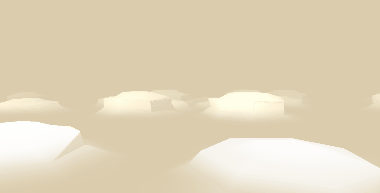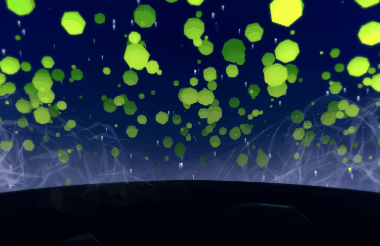Run an image search for “music” on the internet and you’ll get some pretty boring results. Most likely you’ll find a couple silhouettes of headphones, guitars, and pianos, some music notation, illustrated in various states of whimsy, and a few rainbow-colored audio waveforms interspersed for good measure. Synesthetes aside, humans are not great at comprehending sound as a visual sensation without resorting to the symbology of music or depicting the technology used to generate, record, or listen to it. As a retinal experience, music is an abstract concept, which leaves plenty of room for artists to invent their own wild interpretations of what music can look like.
In Fernando Ramallo and David Kanaga’s Panoramical, players modulate vibrant low-poly landscapes, while simultaneously adding and transforming corresponding musical elements of the soundtrack. The play experience is divided into 13 distinct scenes, most of which begin as minimalist vistas, where there’s no real goal beyond tinkering with the audio/visual modulations until you’ve had your fill and are ready to try a different horizon. As players turn virtual or IRL dials (MIDI controllers supported), onyx crags will surge from the ground, white tufts will sink into waves, and pink tendrils will sprout and undulate as the accompanying electronic score pulses and plucks in time. Panoramical plays more like a series of performative digital paintings than a capital V Videogame.
In fact, if Panoramical carries any point of historical software reference, it’s the music visualizers of the late 90s and early 00s. In music playback PC applications like Winamp and Windows Media Player, users could switch from “library” to “visualizer” mode and the application would interpret the currently playing audio track as any number of gyrating shapes and smoky fractal patterns. The audio waveform was often at the center of these procedurally generated visuals, either as a core on-screen element or the algorithmic backbone powering the meter and velocity of the fountains of flaming sparks. Videogames did follow suit with titles like Vib-Ribbon and Audiosurf, which allowed players to load their own music into the game and play through whatever obstacle course the game generated from the waveform data.
However, the key difference with Panoramical is that players control both audio and visuals in real time. Because of this, the connection between sound and shape feels more personally authored (by developer and player) than the computerized outputs of a Winamp visualizer. Players don’t create songs in Panoramical per se, but they are conducting scores and directing music videos simultaneously.
But to get at what truly makes Panoramical special, we need to dig past the admittedly mesmerizing novelty of player controlled music visualization and generation. While it’s certainly entertaining to fully unleash your godlike powers, turning all the knobs to 11 and indulging in the multisensory overload, employing a discerning ear and a more reserved hand opens up a more nuanced compositional endeavor. For example, increasing the presence of particular elements doesn’t raise their volume along a purely linear trajectory. In one scene you can summon a field of white, hair-like threads that carry soft string tones. As you modify the threads to make them squiggly, they emit violin-plucking sounds, as if the curves of the squiggles were audibly snapping into position. In a resting state, even turned all the way up, you won’t hear the plucks unless you actively change the arrangement on the fly.
Thus, playing Paranormical becomes a negotiation of careful editing and active performance. Eventually (hopefully) you’ll hit upon a combination of audiovisual components that just clicks, and the framing conceits of these discrete windowed scenes
will give way to feelings of genuine discovery. The result is a tableau where the juxtaposition of the synth pads and keystrokes naturally comingle amongst the shifting terrain of orange hillsides and inverted waterfalls. I’ve managed to strike such a balance in a solid handful of the scenes at this point. And while none of them are quite as transcendent as peak moments of prior David Kanaga games, the frenzied, psychedelic rush of Dyad or the exquisite, gut-wrenching finale of Proteus, they’re still powerful albeit in a less visceral way. 
Panoramical is not an evolution of the “music game.” A mutation, perhaps, but it’s quite disconnected from the emphasis on execution games of that genre place upon players. Alternatively, Panoramical is about a more exploratory kind of play within a carefully carved-out, unfailable space –akin to figuring out what to do with a simple musical instrument. Playing it is a process of asking “what’s this button do?” and then attempting to arrange something worthwhile with your findings. But there’s none of the punk rawness that usually comes with making sounds with a foreign instrument. Everything in Paranormical is pretty, and so whatever you make will carry the sound of an instrument that’s well-tuned and complementary, even if you don’t know that first thing about composition.
So, it turns out that Panoramical isn’t really a music creation tool either, or at least it’s not going to replace anyone’s copy of Ableton Live. But it’s not trying to. Instead, Panoramical is Ramallo and Kanaga’s vision of what music can look like. It’s an interactive music visualizer and generator that’s content with illustrating the magic of musical arrangement, and on that front, it plays beautifully.
